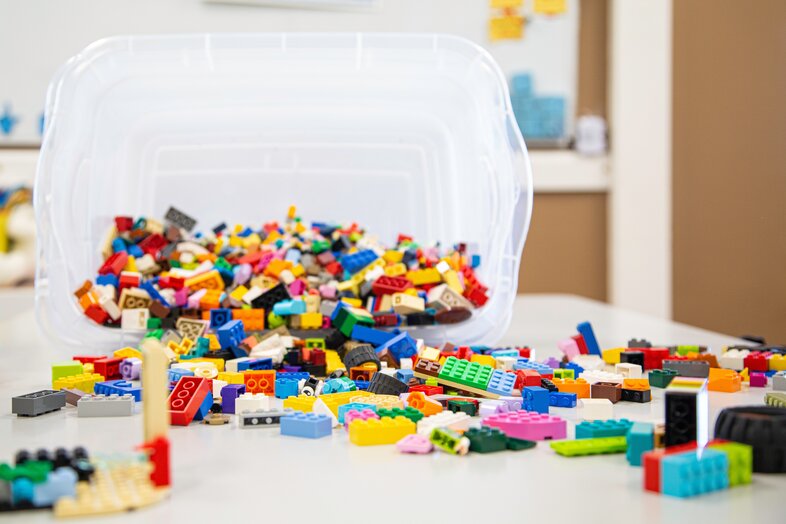The influence of structure
When it comes to materials, the most elaborate designs are often found in nature. "Take, for instance, the bones of a human body," material chemist Jia Min Chin offers an example, "Bones are actually made of very light materials, but they are very strong and don’t break easily." A human bone consists of many types of bone cells that form a sponge-like substance. Minerals are stored in it, especially a lot of calcium, which makes the bone hard and stable. Another component is collagen, which makes the bone elastic. "A very impressively engineered material," Chin concludes, "so if nature can do it, why can't we do the same?"
Studying leaves
Many of the techniques scientists use to create materials were originally inspired by nature. "A well-known method to make materials water-repellent is to integrate micro- and nanostructures into their surfaces." And how did researchers come up with that idea? "They studied the structure of lotus leaves," explained Chin, "eventually, more complex methods were developed, but the original idea came from nature."
Her main scientific interests include bioinspired materials, but also metal-organic frameworks and the development of colloidal materials. "My colleagues and I are interested in finding new ways to assemble man-made materials in the right way," the chemist explains, "Our goal is to develop new methods that will help other scientists improve materials."
Versatile frameworks
Chin joined the Faculty of Chemistry at the University of Vienna as an assistant professor in 2019. Already in 2020, she received an ERC Consolidator Grant to carry out research on field-manipulation of metal-organic framework materials. But what does that mean?
Metal-organic frameworks are a class of molecular materials, built up from ions as well as organic molecules. When they come together, they form one-, two- or three-dimensional structures. "They are interesting to me because they are extremely versatile," Chin explains, "you can pretty much design and assemble any metal you can think of from different organic molecules." Metal-organic frameworks could be compared to Lego bricks in terms of their modularity.
Lego bricks and structures
In the ERC project, they serve as a great platform for the researchers to study the structuring of materials at the molecular level. "We then create nanocrystals and microcrystals, which we use to fabricate macroscale objects." Chin and her colleagues establish new methods for the control of materials across different length scales: "Molecule, nano, micro, macro." The interplay of different length scales in materials is important to their ultimate functions: "So in materials chemistry, we can't just focus on a single length scale."
The goal of the project is to demonstrate the importance of structuring, so that these materials can be used for hydrogen fuel cells, i.e. for the generation of environmentally friendly energy. "It is a proof of concept in this special case," Chin explains, but as the researchers continue their attempts to establish methods that can optimize materials, she thinks the opportunities for application are infinite. The chemist again brings up the example of Lego bricks. Normally, she says, you take pre-existing Lego bricks and build structures out of them: "We, on the other hand, control the growth of the Lego bricks themselves, then we build the structures with them before we finally investigate their performance."
Construction and deconstruction
One of the biggest challenges for the future is deconstruction, Chin believes: How can we break materials back down into their individual components for the sake of environmental sustainability? A good example is plastic. When plastic bags were developed, it was very progressive: a durable material, waterproof, resistant. However, no one thought about how they could deconstruct them. "Potato chip bags, for example, are made of composite films of different materials," the scientist explains, "There are layers of plastic, metal." How do you separate these components again? That's a big challenge if you want to be able to recycle materials. "In materials science we have to think not only about assembly, but also disassembly."
Another challenge, she thinks, is to use starting materials that are not petroleum-based. Right now, many chemicals in the chemical industry still come from petroleum. "We need to get away from that to be able to develop materials with their own life cycle." That's also a political question, Chin adds. The goals of the various industries and also those of science are not necessarily congruent with the ecological challenges the world is facing: "As material chemists we do not only need to think about how we are able to improve the performance of materials but also about the possible problems that could come from our solutions."
Facing future challenges
In her own research, Chin therefore asks herself: Where do our chemicals come from? Can we use cheaper ones that are more renewable? How do we break them down later? She tries to choose non-toxic, earthbound materials: "Instead of toxic transition metals like cobalt or chromium, one can use a less toxic metal." Like many other scientists, she is also moving away from rare metals like platinum and palladium to cheaper ones, especially ones that are not concentrated in poor countries where the extraction would cause many problems for the local population.
"I think that the Austrian Research Promotion Agency (FFG) in Austria is moving very much towards questions of sustainability and circular economies," Chin states. The FFG increasingly demands interdisciplinary proposals that include the social and environmental sciences: "I think that is a good thing, because it forces us to think beyond the narrow perspectives of our own field and science." The chemist feels extremely privileged to be able to work at the University of Vienna to do science with fantastic collaborators and amazing students: "I have a lot of fun with my work," she adds, "and I also encourage my students to have fun with their science!"

